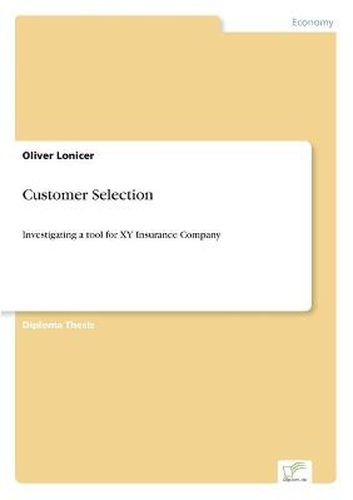Readings Newsletter
Become a Readings Member to make your shopping experience even easier.
Sign in or sign up for free!
You’re not far away from qualifying for FREE standard shipping within Australia
You’ve qualified for FREE standard shipping within Australia
The cart is loading…






This title is printed to order. This book may have been self-published. If so, we cannot guarantee the quality of the content. In the main most books will have gone through the editing process however some may not. We therefore suggest that you be aware of this before ordering this book. If in doubt check either the author or publisher’s details as we are unable to accept any returns unless they are faulty. Please contact us if you have any questions.
Inhaltsangabe: Abstract: In the real world, all customers are not created equal. This allusion to the Declaration of Independence captures a recent realisation of many companies - different customers represent different values to a company. In fact, many companies are discovering that a large percentage of their customers are generating losses. XY Insurance is among those companies that recently discovered a considerable portion of unprofitable customers in their current book of business. This was identified as a major problem, especially considering the fact that the company is converting to a publicly traded stock company. Given the necessity to produce shareholder value, senior management realised that it would be indispensable to ensure the profitability of its accounts. One of the factors underlying this problem at XY is the lack of a screening process to ensure the selection of customers with whom a profitable relationship can be built. To address this need, XY’s senior management decided that it would be necessary to develop a tool that enables the sales staff to evaluate customers, and ultimately, to select customers based an this assessment. The objective of this study is the development of a screening tool which can be used as a basis for the selection of XY’s customers in the company’s arge case segment. The development of the tool is limited to one of the company’s segments because the customers as well as the products differ greatiy by segment. The tool should enable the company to assess their clients individually and classify each of them as ‘attractive’ or ‘unattractive’ so that proper strategies can be applied. The strategy development lies outside of the confines of this study and is therefore not discussed in this paper. I will however, indicate starting-points and some important issues when designing these strategies. In addition, considerations in conjunction with the implementation and introduction process, as well as avenues for further
$9.00 standard shipping within Australia
FREE standard shipping within Australia for orders over $100.00
Express & International shipping calculated at checkout
This title is printed to order. This book may have been self-published. If so, we cannot guarantee the quality of the content. In the main most books will have gone through the editing process however some may not. We therefore suggest that you be aware of this before ordering this book. If in doubt check either the author or publisher’s details as we are unable to accept any returns unless they are faulty. Please contact us if you have any questions.
Inhaltsangabe: Abstract: In the real world, all customers are not created equal. This allusion to the Declaration of Independence captures a recent realisation of many companies - different customers represent different values to a company. In fact, many companies are discovering that a large percentage of their customers are generating losses. XY Insurance is among those companies that recently discovered a considerable portion of unprofitable customers in their current book of business. This was identified as a major problem, especially considering the fact that the company is converting to a publicly traded stock company. Given the necessity to produce shareholder value, senior management realised that it would be indispensable to ensure the profitability of its accounts. One of the factors underlying this problem at XY is the lack of a screening process to ensure the selection of customers with whom a profitable relationship can be built. To address this need, XY’s senior management decided that it would be necessary to develop a tool that enables the sales staff to evaluate customers, and ultimately, to select customers based an this assessment. The objective of this study is the development of a screening tool which can be used as a basis for the selection of XY’s customers in the company’s arge case segment. The development of the tool is limited to one of the company’s segments because the customers as well as the products differ greatiy by segment. The tool should enable the company to assess their clients individually and classify each of them as ‘attractive’ or ‘unattractive’ so that proper strategies can be applied. The strategy development lies outside of the confines of this study and is therefore not discussed in this paper. I will however, indicate starting-points and some important issues when designing these strategies. In addition, considerations in conjunction with the implementation and introduction process, as well as avenues for further